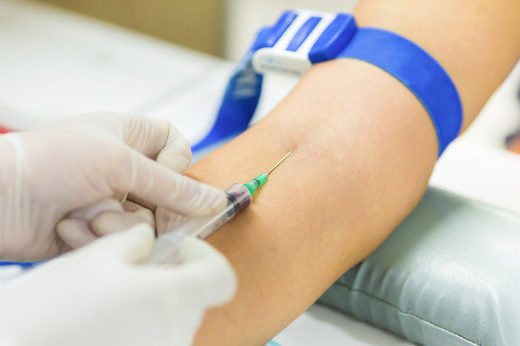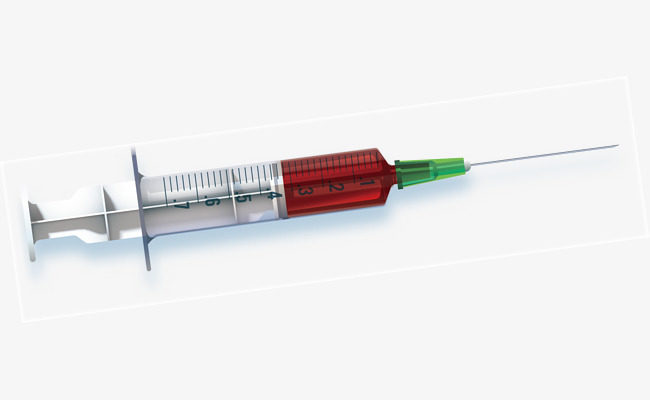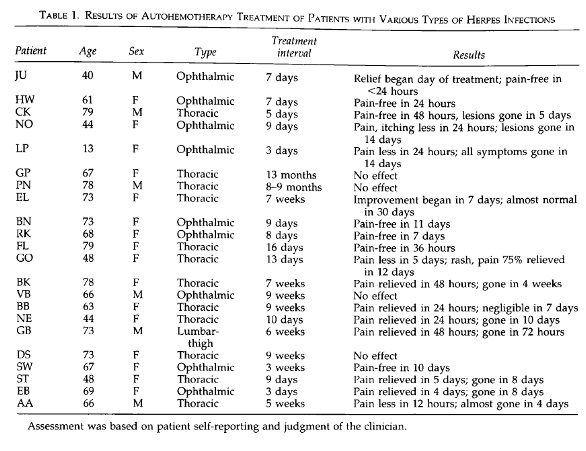To illustrate how this simple technique proved to be useful throughout medical history, we're going to review one of the most astounding research articles on this topic. 'Autohemotherapy in Psychiatry' was published in the Maryland State Medical Journal by Robert Reddick back in 1955 when he was President of the Dorchester County Medical Society. He reports,
Within the last three decades, beneficial effects from the use of autohemotherapy have been reported in the treatment of the following conditions: pulmonary tuberculosis, drug addiction, scarlet fever, acne, carbunculosis, rheumatic fever, various dermatoses, hyperemesis gravidarum, hormone deficiencies, lymphopathia venereum, herpes simplex, herpes zoster, various allergies, fixed serologic reactions, septic conditions following miscarriage and abortion, furunculosis, various virus infections, urticaria, serum sickness, hemiplegia, bronchial asthma, acute chorea, leg ulcers, malaria, pleurisy, rabies, homologous serum jaundice, arthritis, Landry's polyradiculitis, acute anterior poliomyelitis, diphtheritic polyneuritis, duodenal fistula, tuberculous peritonitis, cardiovascular diseases, menstrual and menopausal complaints, various pneumonias, psoriasis and others.That is a pretty compelling list whose track record should not be underestimated. We'll have a look at some of it later on, but first let's go back to Reddick's report on autohemotherapy in a population of psychiatric patients:
In the author's preliminary observations on the use of autohemotherapy in chronic mental disorders in 1950 it was reported that twenty five chronically ill state hospital patients were treated by reinjection of their own blood over a period of six months. The original group consisted of thirteen schizophrenics, six involutionals, three "paranoid conditions," and one each of manic depressive psychosis, psychosis with cerebral arteriosclerosis, and psychosis due to alcohol.I don't know of a single therapeutic approach that can accomplish this nowadays. Perhaps they could claim these results in some very special clinic where they take a multi-therapeutic holistic approach, certainly not in a state hospital using band-aid conventional therapies.
Of this group, nineteen patients or 76 per cent of those treated displayed a social recovery, inasmuch as they were able to leave the hospital and to resume their former activities. Of the six patients still requiring hospitalization at the conclusion of the treatment period, three were much better; two were somewhat better; and one remained unchanged.
Eleven out of thirteen or 85 per cent of the schizophrenics improved sufficiently to no longer require hospitalization, while two-thirds of the involutionals and "paranoid conditions" also displayed a social recovery.
Autohemotherapy was administered once a week for 6 months. The initial treatment consisted of the removal of 5 ml (cc) of blood from one of the median basilic veins (in the arm) under aseptic conditions, followed by immediate deep intramuscular re-injection into the upper outer buttock quadrant. The average length of time which the blood remained in the syringe was fifty-five seconds.
After the third treatment, provided there was no negative reaction to the 5 cc autohemotherapy, the dosage of blood was increased to 10 ml (cc). When the blood was removed from the left arm, it was re-injected into the right buttock and vice versa.

Most of the patients in the treatment group were diagnosed with schizophrenia and some had received electroconvulsive therapy or insulin coma therapy, or both, without improvement. Mental disorders spanned from two to forty-nine years. Twenty-three patients or ninety-two per cent of those treated displayed a social recovery, inasmuch as they were able to leave the hospital and to resume their former activities. Improvement in the rest were also reported. Those in the control physiological solution group remained the same, except for one, who deteriorated and died during hospitalization.
Laboratory analysis showed a lowering of the sedimentation rate (a marker of inflammation) and normalization of protein levels in the blood. A marked lymphocytosis (a component of white blood cells) was documented within a few hours each time autohemotherapy was practiced. One patient had an unusual healing reaction to the autohemotherapy - temporary pustular skin eruptions. This disappeared after spontaneously draining and in two occasions they had to be drained. This same patient had an increase of twenty- two points in the Intelligence Quotient test, meaning that she showed a change from a defective level to a superior level in abstract thinking ability or the ability to form concepts. This was paralleled by the obvious improvement in the patient's attitude, and her acquisition of insight into her condition all of which became evident following this patient's third autohemotherapy session. I highly encourage a reading of the detailed description of this case in the original study. It is worth checking out!
Many theories have been offered as to why autohemotherapy works. Some claim that the blood injected in the muscle acts as foreign body that activates the reticulo-endothelial system, a network of cells and tissues throughout the body and blood (i.e. general connective tissue, spleen, liver, lungs, bone marrow, and lymph nodes). This activation stimulates the immune system and the bone marrow to increase the production of macrophages which then clean the body of harmful microbes, cancer cells, and debris. Just to put an example, the expensive treatment GcMAF claims to give results by increasing macrophages. Autohemotherapy increases the levels of macrophages in the bloodstream for 5 days. As Dina Soliman, M.Sc. explains:
While there is blood in the muscle, the reticulo-endothelial system is being boosted by four times and the maximum boosting finishes only after five days. The normal range of macrophages in the blood is 5% [1], with auto-haemotherapy this rate raising from 5% to 22% over 8 hours and lasting for 5 days [3]. From the 5th to the 7th day the rate starts to drop again going back to 5% of the 7th day. This is why auto-haemotherapy must be repeated every 7 days and can be done for 10, 15 or 20 years with no contra-indications.This has widespread benefits in chronic disease and might explain the positive results seen in autohemotherapy. Soliman conducted a study on 176 patients suffering from different diseases such as diabetes type 1, bronchial asthma, chronic sinusitis, allergic conjunctivitis, allergic rhinitis, skin problems (vesicles, eczema, ulcer), finger nail problems (infection, paronychia), acne vulgaris, gastrointestinal problems, lactose intolerance, connective tissue diseases, fatigue, myasthenia gravis, fibromyalgia, gout, osteoarthritis or arthrosis, lower back pain with Modic changes Type 1 on the MRI (with or without spinal canal stenosis), auto-immune diseases (ankylosing spondylitis, rheumatoid arthritis), and infectious vaginal discharge. In the study, 8 to 12 injections were delivered using 3 to 10 cc of the patient's own blood over a period of 4-6 weeks. The results in those with diabetes type 1 really caught my attention:
The HbA1c of these two [subjects] was measured prior to the start of the treatment and it was 8.5 and 8.9 respectively (normal range 4.6-6). During the treatment they did not change neither their eating habits nor the units of insulin they were using. After 7 months of continuous weekly treatment, they stopped it as they got bored. HbA1c was re-measured 4 months after the stoppage of the treatment and it was 6.3 and 6.9 respectively. Then another 5 months later, HbA1c was re-measured again and it was 8.5 and 9.5 respectively.Glycated hemoglobin (HbA1c) is an indirect marker of a person's blood sugar levels over the last 3 months. It seems that by doing autohemotherapy alone, one can have results that diabetes drugs and insulin treatment can't achieve in certain diabetics. In Soliman's study, every single patient and condition mentioned above was improved.
Perhaps the most well documented beneficial effect of autohemotherapy during the last years is its healing effect in herpes zoster infections. In the elderly, shingles often have very debilitating symptoms with chronic and persistent pain that sometimes won't even respond to opioids. In 1997, Dr John H. Owlin published a paper where he summed up his experience with autohemotherapy in herpes zoster. He reports,
Herpes zoster (shingles) affects a significant number of individuals over age 50. To date, no satisfactory treatment has been available. The clinician author (JHO) witnessed a dramatic response of a shingles patient to autohemotherapy: the pain was completely relieved [within 48 hours] and lesions gone within 5 days with no recurrence of either. Treatment of other herpetic patients then began with autohemotherapy. Twenty-five patients with herpes were given an autologous blood transfer of 10 ml of blood from the antecubital vein into the gluteal bundle and followed for clinical signs. A 100% favorable response occurred in 20 patients who received autohemotherapy within 7 weeks of the onset of clinical signs and 1 other who received autohemotherapy at a 9-week interval. No untoward signs or symptoms of the treatment occurred. Autohemotherapy has been demonstrated to be effective in elimination of clinical sequelae in these cases of herpes infections and these results justify further rigorous clinical investigation.This study included cases of herpes zoster affecting the eyes. In the following table, you can see the evolution of each case:
There's also a very old paper which shows how autohemotherapy is a mild stimulant of the adrenal cortex which then increases secretion of its hormones, resulting in a lower count of circulating eosinophils. This might be specially relevant for those who have urticaria or allergic reactions.
Nowadays, autohemotherapy is prescribed in sports medicine and orthopedics. When the problem has a more chronic degenerative component as in conditions ending in "osis", autohemotherapy might more useful than standard treatment. In 2003, Dr. Scott G. Edwards and James H. Calandruccio published their experience with autohemotherapy in epicondylitis or tennis elbow in the Journal of Hand Surgery. They explain:
Purpose: Most nonsurgical treatments for lateral epicondylitis have focused on suppressing an inflammatory process that does not actually exist in conditions of tendinosis. An injection of autologous blood might provide the necessary cellular and humoral mediators to induce a healing cascade. The purpose of this study was to evaluate prospectively the results of refractory lateral epicondylitis treated with autologous blood injections.In fact, the effects of autohemotherapy throughout the history of its use have been so compelling, that my favored hypothesis is that autohemotherapy actually activates stem cells. This might not be so far-fetched considering that a study published in 2017 showed how electroacupuncture (EA) stimulated mesenchymal stem cell (MSC) release into peripheral blood through the activation of the nervous system. Some consider cupping and acupuncture as indirect ways of doing autohemotherapy.
Method: Twenty-eight patients with lateral epicondylitis were injected with 2 ml of autologous blood under the extensor carpi radialis brevis. All patients had failed previous nonsurgical treatments including all or combinations of physical therapy, splinting, nonsteroidal anti-inflammatory medication, and prior steroid injections. Patients kept personal logs and rated their pain (0 -10) and categorized themselves according to Nirschl staging (0 -7) daily.
Results: The average follow-up period was 9.5 months (range, 6-24 mo). After autologous blood injections the average pain score decreased from 7.8 to 2.3. The average Nirschl stage decreased from 6.5 to 2.0. For the 9 patients receiving more than one blood injection the mean pain score and Nirschl stage before injection were 7.2 and 6.6, respectively. After the second blood injection the pain and Nirschl scores were both 0.9. Two patients received a third blood injection that brought both pain and Nirschl scores to 0.
Conclusions: After autologous blood injection therapy 22 patients (79%) in whom nonsurgical modalities had failed were relieved completely of pain even during strenuous activity. This study offers encouraging results of an alternative minimally invasive treatment that addresses the pathophysiology of lateral epicondylitis that has failed traditional nonsurgical modalities.
My godmother has received stem cell treatments in a specialized clinic and the beneficial effects she derived from that treatment modality are not necessarily better than the ones she has seen from autohemotherapy and other non-conventional treatments. Autohemotherapy is considerably less invasive than stem cell treatment which involves extraction of fat cells from your belly tissue or of bone marrow from your hip bone.
Consider the following quote from a historical review published by S.H. Shakman in Autohemotherapy Reference Manual:
At least two recent articles haveDr. Luiz Moura, a Brazilian doctor, recounts his clinical experience with autohemotherapy in an interview available on youtube. From clinical improvement of peripheral vascular disease documented by angiography to the clearance of acne, his experience is worth listening:
- indicated that the use of reinjected whole blood is comparable to the use of stem cells from the blood, thus preferable in view of its far greater simplicity and ease of rapid administration; and
- asserted that the use of either whole blood or stem cells is preferable to bone marrow
Regardless of the main underlying reasons as to why autohemotherapy is so useful, the track record is pretty outstanding and several testimonials from friends and myself support this record.
Does autohemotherapy have unwanted side effects? Other than the psychiatric case described in the study above, there are other recorded cases of temporary pustulas, urticaria, fever and migratory pains which seem to be a healing crisis of some sort. These symptoms usually resolve in a few days and are typically more frequent in the first sessions. In some cases, psoriasis worsened. As always, do your own homework and consult your doctor before embarking in any healing modality.
References
Scott G. Edwards, James H. Calandruccio. Autologous Blood Injections for Refractory Lateral Epicondylitis. The Journal of Hand Surgery. 2003. doi:10.1053/jhsu.2003.50041
John H. Owlin, Helen V. Ratajczak, Robert V. House. Successful Treatment of Herpetic Infections by Autohemotherapy. The Journal of Alternative and Complementary Medicine. Volume 3, n. 2, 1997, pp 155-158.
Robert H. Reddick, Autohemotherapy in Psychiatry, Maryland State Medical Journal (1955).
Gordon C. Sauer. Evidence of Adreno-Cortical Stimulation by Autohemotherapy. The Journal of Investigative Dermatology. 1950.
S. Hale Shakman. (1998) Autohemotherapy Reference Manual: Definitive Guide & Historical Review, From Bloodletting to Stem Cells. Createspace
Dina Soliman. New Erra with Auto-Haemotherapy. Journal of Physical Science and Application 7 (2) (2017) 31-35. doi: 10.17265/2159-5348/2017.02.005





Reader Comments
As an aside, jokingly, should you change your name to Rick Pisses?
As it were, this turbo-charges autohemotherapy.
Upon first reading, this sounds like one of those troll joke papers submitted to a science journal just to see if it would be accepted.
Looks like I know what I'm going to be researching for the next few hours. sigh.
My second thought is that if it's a real thing, that it works along the lines of cold therapy; activating the body's self-protection/repair responses in a way that deals with other issues and infections which sneaked past the radar and maintain their existence by being subtle little pathogenic creepers. -But which aren't subtle or sneaky enough to survive a nuclear attack triggered by an unrelated cause. -And being that it's your own blood, means that it's complex enough to set off alarms, but home grown enough to be 100% non-toxic.
I remember once having a years-long fungal infection on a toe which powders and sunlight and creams and bath salts didn't cure. But nearly breaking my damned foot after an ill-advised kick against a piece of furniture, aside from making me hobble around for the next couple of days and causing my toe to swell up, had the surprising and welcome effect of totally clearing up the fungal infection.
That's one theory anyway. Who knows? Maybe I just inadvertently kicked the crap out of an ugly little spirit attachment which had taken up residence in my shoe?